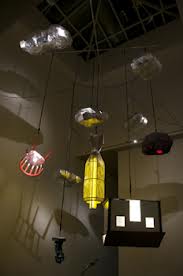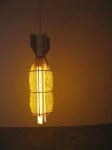


Martin Kersels
American, 1960-
Charms (Black Cloud / Green Dog / Little, Little Boy / Red Chair / White House / Silver Clouds), 2012
found and constructed objects
138 in.
SBMA, Museum purchase with funds provided by The Museum Contemporaries
2012.44a-k

Julie Joyce, SBMA Curator of Contemporary Art, and Martin Kersels, photographed during installation.
RESEARCH PAPER
Martin Kersels’ “Charms” series incorporates found objects and shapes that hang from the ceiling. The nine sculptures that comprise this installation, commissioned for the Museum’s Park Entrance, (Little,Little Boy; Green Dog; Red Chair; Black Cloud; White House; and five Silver Clouds) are suspended from a large ring—like charms on a bracelet. Several sculptures incorporate lighting elements and reflective surfaces, which cast light and shadow on the interior walls. The Charms, according to Kersels, project a sense of “comfort and familiarity played against the anxiety-producing images of a bomb amidst silver, alien-like clouds. While there is no specific narrative, they are deliberate and dynamic in their construction and suspension.”
This is a very large work, approximately 24’ x 16’; it is perhaps the largest work currently in the Museum. The nine “charms” hang from the ceiling over the stairs at the Park Entrance. Looking up, the viewer sees a large, lighted yellow bomb (Little, Little Boy), a child’s red chair (upside down with a light), and a small green inverted statue of a dog holding an empty basket in its mouth (Green Dog). Another item is a cardboard house (also upside down) with a light in it. These items are interspersed with clouds--large silver ones, and one black cloud containing a red light bulb. Climbing the stairs, the viewer may look at the work from several other angles near the top.
The artist likens these hanging sculptures to how we think of such objects—as “funny and possibly real…even tragic” (Julie Joyce, 2014). The series takes its inspiration from the meanings and implications of the word “charm,” which may be defined as a talisman that embodies a sense of protection, magic, mystery or even a curse. The ideas inherent in these concepts appeal to the artist, as to the way these tokens are used as a keepsake, a memento, or even as adornment. Such notions of mystery and magic also play into Kersels’ continued exploration of life and the world we live in—the way we navigate pleasure and pain, which also can have both positive and negative effects.
Humor pervades this artist’s work, speaking to the joys, sorrows, and frustrations inherent in the human condition. Scale frequently has much to do with his work, particularly in a sculpture such as Little, Little Boy. Named after “Little Boy,” the code name for the atomic bomb dropped on Hiroshima August 5, 1945; this piece becomes bitingly ironic, using a diminutive name for something with such devastating impact.
Black Cloud taps into the way we think about this image as simultaneously amusing and tragic. It points to a sense of failure, reminiscent of those hovering over the heads of cartoon characters. Interestingly, Black Cloud hangs above White House.
Silver Clouds bring to mind the phrase that every cloud has a positive aspect. They may provide a sardonic balance to Black Cloud. White House suggests either something familiar or an icon that stirs political and patriotic sentiments. Finally, Green Dog may be seen as a sort of mascot—for the artist, for the Museum, or even for the viewer.
Martin Kersels is a prominent Southern California artist whose work represents a delightful merging of found and constructed objects. He was born in Los Angeles, and earned a BA and MFA from UCLA. He is a large man, portrayed as up to six foot eight, and weighing up to 364 pounds. This point is evident in his work in various media – from film and performance, to photography, sculpture and installation. Much of his work is self-referential, and he is most often described by his physical size. As we seem from this installation, this man’s work is BIG!
Mr. Kersels’ work is in many prominent collections, including the Museum of Contemporary Art, Los Angeles; LACMA, MCA San Diego, Centre Georges Pompidou; Museo d’Art Contemporarani de Barcelona; and significant solo exhibitions. These include “Martin Kersels; Heavyweight Champion,” a survey of his work, at the Tang Teaching Museum and Art Gallery at Skidmore College in 2007 (which traveled to Santa Monica Museum of Art). He has been included in three Whitney Biennial exhibitions. A selection of notable exhibitions includes Departures: 11 Artists at the Getty (1999), The Power of Suggestion; Narrative and Notation in Contemporary Drawing at the Museum of Contemporary Art, Los Angeles (1996), and La Belle et La Bête; Un Choix de Jeunes Artistes Americains at the Musee d’Art Moderne de la Ville de Paris (1995).
Martin Kersels is currently Associate Professor and Director of Graduate Studies in Sculpture at Yale University.
Prepared for Santa Barbara Museum of Art Docent Council, by Ann Marshall, January 2014
Bibliography
http://whitney.org/Exhibitions/2010Biennial/Martin Kersels.
“MARTIN KERSELS: HEAVYWEIGHT CHAMPION,” The Frances Young Tang Teaching Museum and Art Gallery at Skidmore College¸ 2007.
Santa Barbara Museum of Art, Curatorial File, Contemporary Art, 2014.
Smith, Roberta. “ MARTIN KERSELS.” New York Times. Arts in Review 27
September, 1996.

Early photo of Kersels preforming
SBMA CURATORIAL LABELS
The Santa Barbara Museum of Art announces the installation of nine newly commissioned sculptures from the “Charm” series by renowned artist Martin Kersels. This special installation debuted at the Museum on November 10, 2012 and remains on view for an extended period.
Martin Kersels’s Charms incorporate found objects and shapes to form iconic sculptures that hang from the ceiling. The nine sculptures from the series that comprise the installation, Little, Little Boy; Green Dog; Black Cloud; White House; and five Silver Clouds, are suspended from a large ring—like charms on a bracelet. Several sculptures incorporate lighting elements and reflective surfaces which cast light and shadow on the interior walls. The Charms, according to Kersels, project a sense of “comfort and familiarity played against the anxiety-producing images of a bomb amidst silver, alien-like clouds. While there is no specific narrative, they are deliberate and dynamic in their construction and suspension.”
Kersels likens the Charms to how we think of such objects—as “funny and possibly real…even tragic.” The series takes its inspiration from the meanings and implications of the word, which may be best defined as a talisman that embodies a sense of both protection and danger. The ideas inherent in these polar concepts appeal to the artist, as do the way charms are used as a keepsake, a memento, or even as adornment. Such notions also play into the Kersel’s continued exploration of the space between life and the world we live in—the way we navigate pleasure and pain, which can also have both positive and negative effects.
Kersels has been the focus of many significant exhibitions, including Martin Kersels: Heavyweight Champion, a survey of his work in 2007 at the Tang Teaching Museum and Art Gallery at Skidmore College (traveled to Santa Monica Museum of Art in 2008). He has been included in three Whitney Biennial exhibitions (2010, 2008, and 1997). A selection of notable group exhibitions includes Departures: 11 Artists at the Getty (1999), The Power of Suggestion: Narrative and Notation in Contemporary Drawingat the Museum of Contemporary Art, Los Angeles (1996), and La Belle et La Bete: Un Choix de Jeunes Artistes Americains at the Musee d’Art Moderne de la Ville de Paris (1995).
Works by Martin Kersels are in many prominent public collections, including the Museum of Contemporary Art, Los Angeles; the Los Angeles County Museum of Art, the Museum of Contemporary Art San Diego, the Centre Georges Pompidou, Paris; the Museu d’Art Contemporani de Barcelona; and others. Kersels was recently appointed Associate Professor and Director of Graduate Studies in Sculpture at Yale University in 2012. Prior, he served as a faculty member and Co-Director of the Art Program at the California Institute of the Arts.
Kersels is recognized for sculptures which he calls “performative objects”—machine-like sculptures that often move or generate sounds, taking over any given space and functioning as awkward stand-ins for the artist himself. His “Charm” series is inspired by the multiple meanings and implications of the word, which include the notion of a talisman embodying a sense of protection or perhaps even a curse. In this installation, made specifically for the Museum’s Park Entrance, a collection of charms dangle from a large ring, much like gigantic charms on a bracelet. According to Kersels “there is no specific narrative, (yet) they are deliberate and dynamic in their construction and suspension.” This particular arrangement of the artist’s “Charms” projects a sense of “comfort and familiarity played against the anxiety-producing images of a bomb amidst silver, alien- like clouds.”
Humor pervades Kersels’ work, speaking to the joys, sorrows, and frustrations that are inherent characteristics of the human condition. Scale frequently has much to do with this, particularly in a sculpture such as Little, Little Boy. Named after “Little Boy,” the codename for the atomic bomb dropped on Hiroshima on August 6, 1945, this piece becomes bitingly ironic from the use of a diminutive name for something with such a devastating impact. Black Cloud taps into the way we think about this cartoon-like image as simultaneously amusing and tragic, and points to the sense of failure that is also prevalent in the artist’s work. Silver Clouds, bringing to mind the phrase “every cloud has a silver lining,” may provide a sardonic balance to Black Cloud. White House suggests either something simple and familiar or an icon that for many of us stirs up political and patriotic sentiments. And finally, Green Dog may be seen as a sort of mascot—for the artist, for the Museum, or even perhaps for the viewer.
“It starts with performance for me” states Martin Kersels, beginning one of the many lectures he has been invited to present since he began exhibiting in the late 1990s. During the previous decade—before becoming a sculptor, photographer, as well as a video, installation and sound artist—Kersels was a member of SHRIMPS, a performance collaborative from Los Angeles that gained national recognition in the 1980s.
The group started as “large men doing diminutive movement,” then proceeded to “large men with small women who would kick our asses when we were trying to do diminutive movement,” before Kersels eventually broke off on his own. What he values most from those early years, however, was that he was “part of this collaborative… It was truly a godsend to me to be in a group where I could express ideas and take part in things without having the whole responsibility on me.”
This is just one of the reasons why I was excited to work with Kersels to bring his forthcoming installation, Charms, to SBMA. The installation, made specifically for the Museum’s Park Entrance and on view beginning November 10, is an assortment of sculptures that dangle from a large ring, much like gigantic charms on a bracelet. Providing visitors with this assemblage of talismans, hanging overhead as they pass through the Park Entrance atrium, Charms is characterized by elements of Kersels’ trademark physical presence and humor, both light as well as dark.
- SBMA Wall Text, 2012
- SBMA Blog, 2012
http://haudenschildgarage.com/4927/charms-by-martin-kersels-at-the-santa-barbara-museum-of-art.htm
